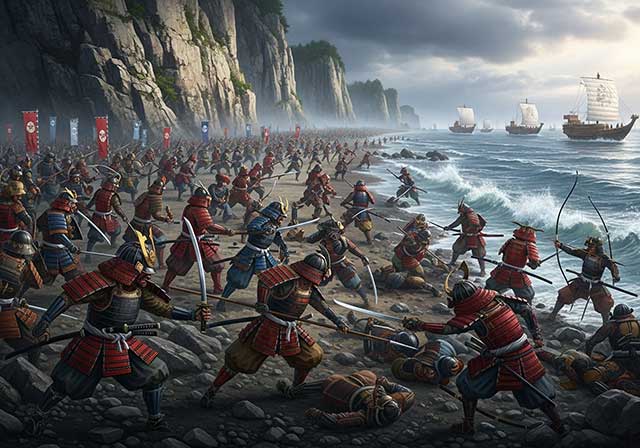
After the death of Minamoto no Yoshinaka, the Genpei War entered its final phase, which is closely associated with the name of Minamoto no Yoshitsune. On March 13, 1184, he and his brother Noriyori set out to accomplish what their cousin had failed to do: deliver a final defeat to the Taira.
Itinotani Fortress
Yoshitsune's next target was Itinotani, where the Taira forces had concentrated and built fortifications. Their location was exceptionally convenient for defense. On the border between the provinces of Settsu and Harima, west of present-day Kobe, stood a fortress that was not a castle but a sturdy palisade. The narrow coastal strip of land was protected on one side by steep cliffs forming a natural northern wall, and on the other by the sea, where the Taira fleet was anchored. This place seemed impregnable, especially for a clan closely associated with the sea.
The plan of attack
The Minamoto carefully devised a plan of attack. Noriyori was to move along the coast from the east, while Yoshitsune intended to make a flanking maneuver through the lands of Settsu and approach the fortress from the west. A simultaneous attack from two sides could give them a chance to break through the Taira's defenses before they had time to take the emperor and flee to sea.
Yoshitsune's rapid march
After developing a strategy, Noriyori began his advance along the coast from the east. At the same time, Lord Kuro (one of Yoshitsune's nicknames), together with warriors under the command of Miura Juro Yoshitsura, set out for Mount Ichinotani. His march was lightning fast: the journey from Kyoto to the eastern slope of Mount Mikasa, which usually took two days, took him only one. There, the borders of three provinces converged: Tamba, Settsu, and Harima.
On March 16, when night fell, Yoshitsune was informed that the Taira camp, numbering about three thousand men, was located eight miles to the southwest. Without allowing his men to rest, he immediately decided to attack. By torchlight, his troops rushed forward. The Taira warriors, losing their composure, were defeated and fled.
Preparing for the assault
The next day, March 17, Kuro Onzōshi (as Yoshitsune was called as the direct heir to the clan) divided ten thousand horsemen into two detachments. Tōjiro Sanehira received seven thousand men and was to advance on the western slope of Ichinotani. Yoshitsune himself, with three thousand horsemen, decided to make a flanking maneuver through the pass and strike the Taira from behind from the direction of Tamba.
At the same time, Kumagae Jiro Naozane and Hirayama Musha-dokoro Suesige from Musashi Province were the first to set out on the road to Ichinotani. Competing with each other, they attacked the enemy from the sea and loudly proclaimed that they were ahead of Minamoto's main forces.
The first clashes
They were met by the Taira commanders: Hida Saburo Kagetuna, Etchu Jiro Moritsugu, Kazusa Goro Tadamitsu, and Akushitsu Kagekiyo. Their troops numbered twenty to thirty horsemen, and they threw open the wooden gates and entered the battle. During the battle, Kumagae Kojiro Naoe was wounded and the warrior Suesige was killed.
Soon, Noriyori arrived at the head of troops from Ashikaga, Tichibu, Miura, and Kamakura. The battle turned into a fierce melee, where white and red banners were mixed together.
Panic in the Taira camp
Murakami Motokuni's troops set fire to the huts and temporary houses where the Taira troops were quartered. A strong wind drove the black smoke down, and panic broke out in the enemy ranks. Many rushed to the sea, hoping to escape on ships. Ships stood on the shore, and warriors in armor raced to jump into them. One ship could hold four hundred, five hundred, sometimes even a thousand people, which made it impossible to sail away.
When several ships did manage to leave the shore, they did not get more than three hundred yards away before the three largest of them sank. The lower-ranking soldiers who tried to break through to the ships were killed right on the shore. They were cut down with swords and halberds, but even knowing their fate, they continued to cling to the sides of the ships. Some had their arms cut off, others had their joints broken, and they fell, covered in blood, onto the sand of Itinotani.
Death and captives
Among the first members of the Taira family to die was Taira Tadanori, the hero of the Battle of Uji, who had survived at Kurikara. His nephew, Shigehira, also tried to reach the boats. His horse carried him farther than anyone else, but an arrow pierced his sacrum. Jumping to the ground, he tried to drown himself, but found himself in shallow water. Then he grabbed a dagger, intending to commit harakiri, but one of Minamoto's warriors arrived and took him alive — a rare occurrence at that time.
Outcome of the battle
Yoshitsune's lightning attack ended in the complete defeat of Taira at Ichinotani. More than a thousand warriors were killed, including nine generals. At Akashi Bay, Kagetoki and Iekuri captured Taira no Shigehira, a third-rank captain of the palace guard. The governor of Etzena, Mitomori, fell at the Minato River at the hands of Gensan Toshitsuna.
In total, the troops of Yoshitsune and Noriyori destroyed or captured many noble Taira warriors: the governor of Satsuma, Tadanori; the governor of Wakasa, Tsuneyoshi; the governor of Musashi, Tomoaki; Atsumori, a fifth-rank warrior; and Narimori, the former governor of Etzen, Moritoshi. Governor of Totomi Yoshisada captured former governor of Tajima Tsunemasa, governor of Noto Noritsune, and governor of Bitchu Moromori.
See also
-
The Siege of Hara Castle

The Shimabara Rebellion of 1637–1638, which culminated in the siege of Hara Castle, was the last major uprising of the Edo period and had serious political consequences.
-
Battle of Tennoji

The confrontation between Tokugawa Ieyasu and Toyotomi Hideyori during the “Osaka Winter Campaign” ended with the signing of a peace treaty. On January 22, 1615, the day after the treaty was signed, Ieyasu pretended to disband his army. In reality, this meant that the Shimazu forces withdrew to the nearest port. On the same day, almost the entire Tokugawa army began filling in the outer moat.
-
Siege of Shuri Castle

The Ryukyu Kingdom was established in 1429 on Okinawa, the largest island of the Ryukyu (Nansei) archipelago, as a result of the military unification of three rival kingdoms. In the following years, the state's control spread to all the islands of the archipelago.
-
The Siege of Fushimi Castle
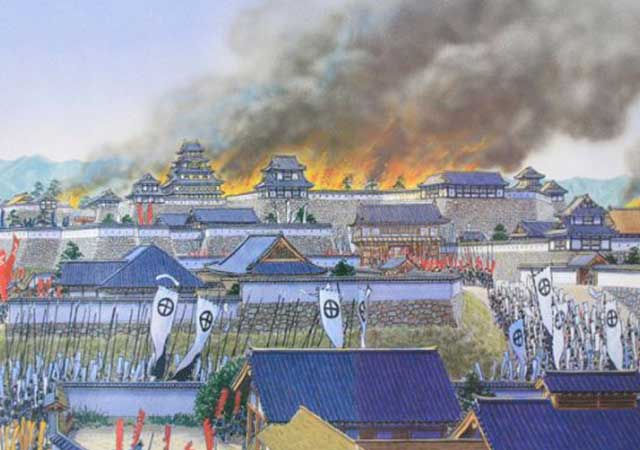
Fushimi can perhaps be considered one of the most “unfortunate” castles of the Sengoku Jidai period. The original castle was built by Toyotomi Hideyoshi in the southeast of Kyoto in 1594 as his residence in the imperial city.
-
The Siege of Otsu Castle
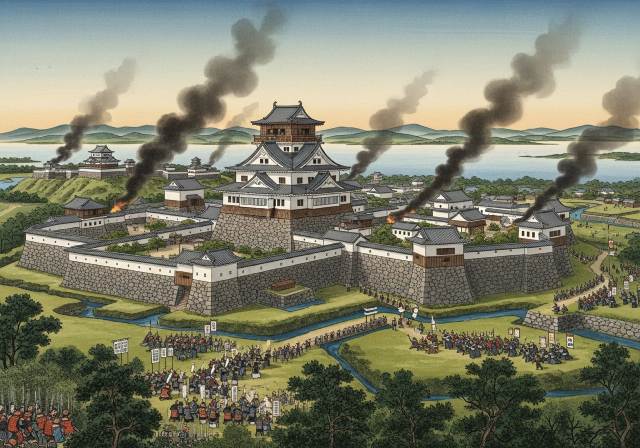
The siege of Otsu Castle was part of the Sekigahara campaign, during which the so-called Eastern Coalition, led by Tokugawa Ieyasu, fought against the Western Coalition, led by Ishida Mitsunari. Otsu Castle was built in 1586 by order of Toyotomi Hideyoshi near the capital Kyoto, on the site of the dismantled Sakamoto Castle. It belonged to the type of “water castles” — mizujō — as one side of it faced Japan's largest lake, Lake Biwa, and it was surrounded by a system of moats filled with lake water, which made the fortress resemble an island.
-
The Siege of Shiroishi Castle
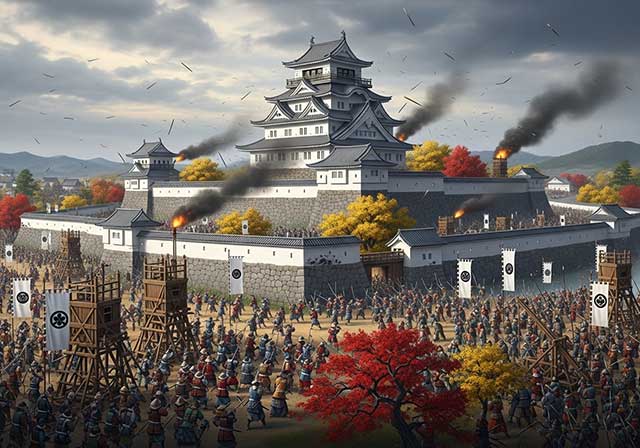
The siege of Shiroishi Castle was part of the Sekigahara campaign and took place several months before the decisive battle of Sekigahara. The daimyo of Aizu Province, Uesugi Kagekatsu, posed a serious threat to Tokugawa Ieyasu's plans to defeat the Western Coalition, and Ieyasu decided to curb his actions with the help of his northern vassals. To this end, he ordered Date Masamune to invade the province of Aizu and capture Shiroishi Castle.
-
The Second Siege of Jinju Castle
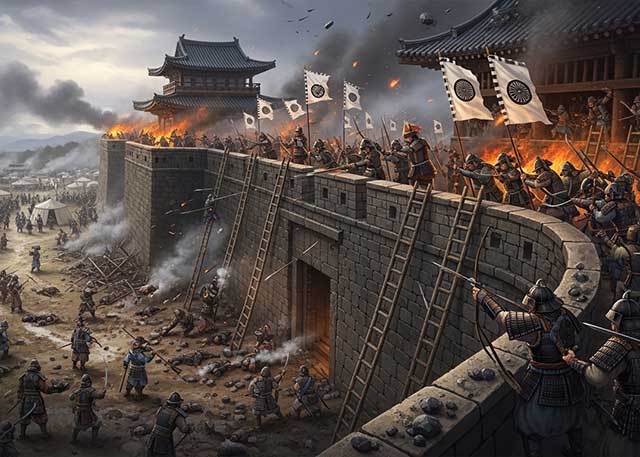
During the two Korean campaigns of the 16th century, the Japanese repeatedly had to capture enemy fortresses and defend occupied or constructed fortifications from the combined Korean and Chinese forces. Among all the operations of that time, the second siege of Jinju Castle is considered the most interesting from the point of view of siege warfare.
-
The Siege of Takamatsu Castle
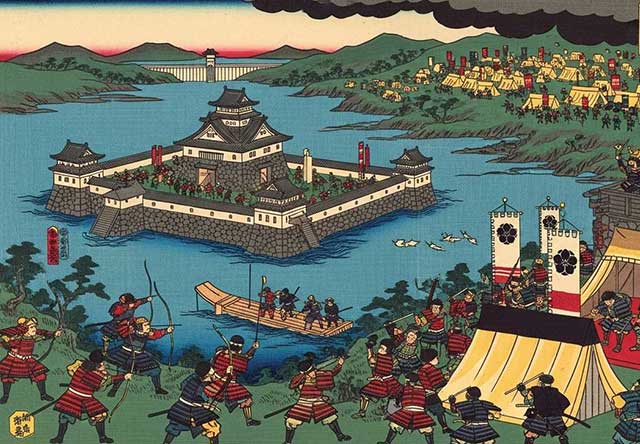
The siege of Takamatsu Castle in Bitchu Province is considered the first mizuzeme, or “water siege,” in Japanese history. Until then, such an original tactic had never been used.

